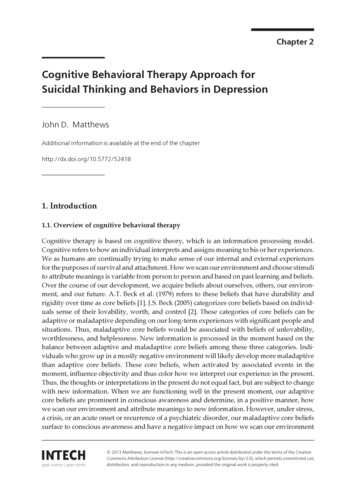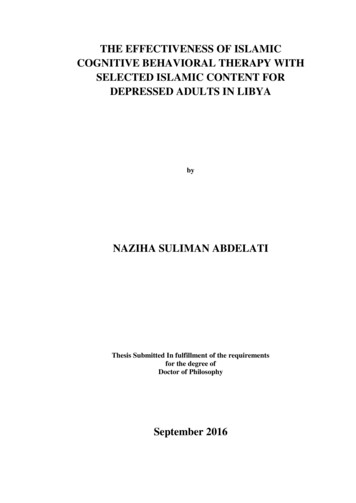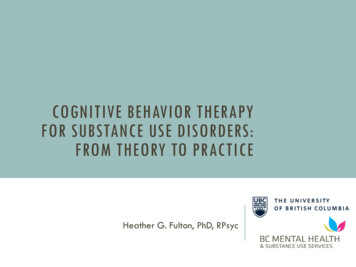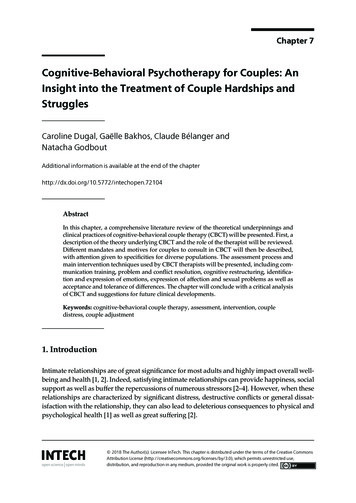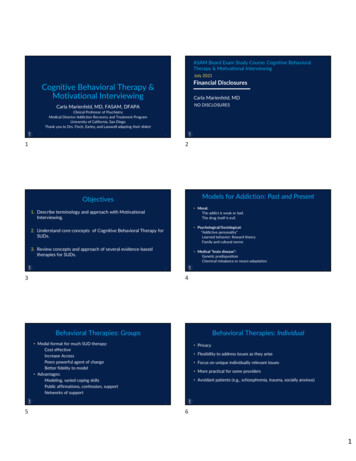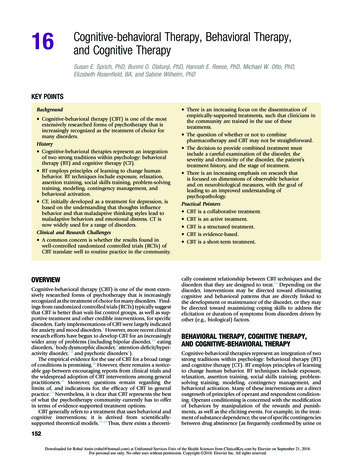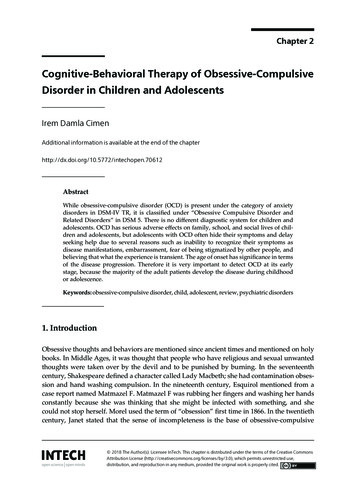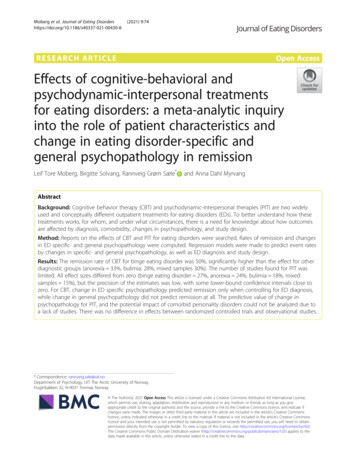
Transcription
Moberg et al. Journal of Eating 8(2021) 9:74RESEARCH ARTICLEOpen AccessEffects of cognitive-behavioral andpsychodynamic-interpersonal treatmentsfor eating disorders: a meta-analytic inquiryinto the role of patient characteristics andchange in eating disorder-specific andgeneral psychopathology in remissionLeif Tore Moberg, Birgitte Solvang, Rannveig Grøm Sæle*and Anna Dahl MyrvangAbstractBackground: Cognitive behavior therapy (CBT) and psychodynamic-interpersonal therapies (PIT) are two widelyused and conceptually different outpatient treatments for eating disorders (EDs). To better understand how thesetreatments works, for whom, and under what circumstances, there is a need for knowledge about how outcomesare affected by diagnosis, comorbidity, changes in psychopathology, and study design.Method: Reports on the effects of CBT and PIT for eating disorders were searched. Rates of remission and changesin ED specific- and general psychopathology were computed. Regression models were made to predict event ratesby changes in specific- and general psychopathology, as well as ED diagnosis and study design.Results: The remission rate of CBT for binge eating disorder was 50%, significantly higher than the effect for otherdiagnostic groups (anorexia 33%, bulimia: 28%, mixed samples 30%). The number of studies found for PIT waslimited. All effect sizes differed from zero (binge eating disorder 27%, anorexia 24%, bulimia 18%, mixedsamples 15%), but the precision of the estimates was low, with some lower-bound confidence intervals close tozero. For CBT, change in ED specific psychopathology predicted remission only when controlling for ED diagnosis,while change in general psychopathology did not predict remission at all. The predictive value of change inpsychopathology for PIT, and the potential impact of comorbid personality disorders could not be analyzed due toa lack of studies. There was no difference in effects between randomized controlled trials and observational studies.* Correspondence: rannveig.sale@uit.noDepartment of Psychology, UiT The Arctic University of Norway,Huginbakken 32, N-9037 Tromsø, Norway The Author(s). 2021 Open Access This article is licensed under a Creative Commons Attribution 4.0 International License,which permits use, sharing, adaptation, distribution and reproduction in any medium or format, as long as you giveappropriate credit to the original author(s) and the source, provide a link to the Creative Commons licence, and indicate ifchanges were made. The images or other third party material in this article are included in the article's Creative Commonslicence, unless indicated otherwise in a credit line to the material. If material is not included in the article's Creative Commonslicence and your intended use is not permitted by statutory regulation or exceeds the permitted use, you will need to obtainpermission directly from the copyright holder. To view a copy of this licence, visit http://creativecommons.org/licenses/by/4.0/.The Creative Commons Public Domain Dedication waiver ) applies to thedata made available in this article, unless otherwise stated in a credit line to the data.
Moberg et al. Journal of Eating Disorders(2021) 9:74Page 2 of 12Conclusions: CBT showed consistent remission rates for all EDs but left a substantial number of patients not inremission. Extant evidence suggest that PIT is not consistently effective in achieving remission for patients with EDs,although this finding is uncertain due to a small number of eligible studies. A group of patients with eatingdisorders may, however, require therapy aimed at strengthening deficits in self functions not easily ameliorable bycognitive behavioral techniques alone. Further research should be aimed at identifying treatment interventions thathelps patients change behavior, while strengthening self-functions to substitute eating-disordered behavior in thelong-term.Plain English summaryTo help people with eating disorders (EDs) recover it is important to know what makes therapies effective or not.Therefore, we summarized the effects of two common therapies for eating disorders, cognitive behavior therapy(CBT) and psychodynamic-interpersonal therapy (PIT) and examined how ED diagnosis, comorbid personalitydisorder and changes in psychopathology could influence ED remission. We found that CBT was most consistentlyeffective, with about 1/3 of patients in remission for anorexia, bulimia, and mixed samples, and 50% for patientswith binge eating disorder. The effects of PIT were uncertain due to a lack of studies and could be only marginallyeffective. In CBT, changing the patients’ eating disordered thoughts or their depression or anxiety was notassociated with ED remission. We discuss why this may be and suggest that CBT may be more effective because itmanages to engage a subgroup of patients who are motivated to change and less depressed or anxious. Thus,patients with more severe symptoms may benefit less. We conclude that CBT may be necessary to help peoplerecover from eating disorders, but that some patients may still require interventions aimed at strengthening selffunctions to substitute eating disordered behavior in the long-term.Keywords: Eating disorders, Cognitive-behavioral therapy, Psychodynamic therapy, Interpersonal therapy, Treatmenteffect, Psychopathology, Remission, Meta-analysis, RegressionBackgroundThe process of psychotherapy for eating disorders (EDs)are complicated by several features of these multifacetedpsychiatric states. Rates of dropout from treatment rangefrom 20 to 73%, and patients often have chronic coursesof illness [1, 2]. EDs are associated with significant medical complications [3], and increased mortality [4]. Thereare different theoretical understandings of EDs, pertaining to their etiology and maintaining factors, and thushow best to address the difficulties patients face intreatment.Although different diagnostic criteria are listed in theDiagnostic and Statistical Manual of Mental Disorders,(DSM-5) [5] for three discrete subtypes of EDs; anorexianervosa (AN), bulimia nervosa (BN), and binge eatingdisorder (BED), diagnostic crossover between these diagnoses over time is a common phenomenon [6, 7]. Adding to the complexity of the clinical state of the patientwith an ED are varying degrees of interpersonal difficulties and other comorbid psychiatric states, making several clinical features relevant to treatment and prognosis.Personality disorders (PDs) have been estimated to becomorbid with AN and BN in 50% of the cases [8]. Also,a large comorbidity survey for EDs [9] showed high ratesof comorbid disorders (depressive, anxiety and substanceuse) across ED diagnoses (56% for AN, 94% for BN and78% for BED). For patients with EDs, psychiatriccomorbidities [10], and interpersonal difficulties, e. g. inthe form of excessive social dominance, coldness, selfsacrifice or non-assertiveness [11] are associated withpoor outcomes of psychotherapy, and persistence ofeating-disordered symptoms.Two historically prominent theoretical frameworks forunderstanding the psychopathology present in EDs are(a) the cognitive-behavioral model, adapted to the symptomatology and clinical presentations of EDs [12, 13]and (b) the psychodynamic [14] or interpersonal [15]models converging on the emphasis of the role of othersin the development of the self, and relating psychopathology to a developmentally based deficit in selffunctions. Regarding the treatment of EDs, these twotraditions are distinguished by the extent to which theytarget eating-disordered cognitions and behaviors - whatmakes EDs special, or aspects of self-functions that arepertinent to all psychiatric disorders. The focus of thismeta-analytic review was the treatment effects of thesetheoretically different treatment approaches.According to the transdiagnostic cognitive-behavioralmodel of EDs [13], eating-disordered behaviors areaimed at controlling body weight and shape, and includedietary restriction, and compensatory strategies such aslaxative use, vomiting and excessive exercise. For somethese efforts results in occasional loss of control, characterized by subjective or objective episodes of binge-
Moberg et al. Journal of Eating Disorders(2021) 9:74eating. All eating disordered behaviors are assumed tobe driven by the core eating-disordered cognitions, i.e.,the over-evaluation of shape and weight, and their control. For patients with EDs, self-evaluation is basedlargely on the extent to which they can control theirshape and weight. The cognitive and behavioral traitsare assumed to be mutually reinforcing and selfperpetuating maintaining mechanisms seen in AN, BNand BED [13]. Cognitive behavioral therapies aim tomodify the cognitive triangle consisting of thoughts,emotions, and behavior by means of cognitive restructuring, and actively altering behavioral patterns [16, 17].On the other hand, EDs can be regarded as disordersof the self. Psychodynamic and interpersonal theorieshave emphasized that deficiencies in self-cohesion, selfworth and self-agency challenge a person’s ability tocontain emotional experiences and needs as real and legitimate, and understanding the affective, motivational,and cognitive states of the self and others [18–20]. Manifestations of these deficiencies may include emotiondysregulation, interpersonal difficulties [21] and eatingdisordered behavior [22, 23]. In people with EDs deficient self-functioning has been associated with generalpsychopathology such as anxious and depressive features[24, 25]. Eating disordered behaviors have been found tobe effective strategies for regulating emotions [26] interpersonal relations and sense of self-worth and -agency[27, 28]. Experienced emotional distress may thus be animportant maintaining factor, linking deficiency in thepatient’s self-functions with the ED specific cognitiveand behavioral features of EDs. The aim ofpsychodynamic-interpersonal therapy is to heighten thepatient’s awareness, acceptance, and tolerance ofaffective experiences. Furthermore, the aim is to helpthe patient to integrate and contain previously disavowed affective and motivational content into the senseof self [14].The National Collaborating Centre for Mental Health[29] recommends outpatient psychotherapy as a firstline treatment for EDs. Symptom-focused CBT is recommended for AN, BN and BED. For AN, it is also recommended using psychodynamic or interpersonal therapyapproaches, but no specific therapy is recommendedover another.Treatment effects for CBT relative to other treatmentshave been established through several meta-analyses ofrandomized controlled trials (RCTs). CBT has demonstrated effectiveness in reducing eating-disordered cognitions [30] depressive symptoms [31] and increasingquality of life [32]. Furthermore, reduction of ED psychopathology predicted the reduction of behavioralsymptoms for BN and BED samples [30], and reductionof binge/purge symptoms have been found to predictgreater reduction of depressive symptoms in BN samplesPage 3 of 12receiving CBT, compared to other treatments [31].These findings lend preliminary support for thecognitive-behavioral model of EDs, and thus the core behavioral and cognitive symptoms as principal targets oftherapeutic interventions.Inferences as to the effect of other specified therapeutic approaches have, however, been difficult to makefrom meta-analyses of RCTs, e.g., [30–35] because effectsizes have been based on differences between treatmentarms containing heterogenous interventions (e.g. different combinations of active experimental treatments,multimodal interventions and different variants of treatment as usual or active psychotherapy control conditions). Rates of ED remission, in terms of abstinencefrom ED behaviors have, however been synthesized intwo meta analyses of RCTs for BN [36] and BED [37].For BN, the rate was 30% and for BED 45%. Such figuresare to date missing for AN. CBT was found to yield thehighest ED remission rates for BN and interpersonaltherapy for BED.While RCTs are widely regarded as the gold standardfor establishing the efficacy of a psychotherapy, concernshave been raised that some features of RCTs may compromise their external validity, e.g., restrictive patient inclusion criteria regarding comorbidity and otherpsychopathology, and strict adherence to a predefinedtherapy protocol [38]. Knowing the wide range of problems often associated with EDs, the standardization ofboth presenting problems and therapy protocol may prevent generalization of therapy outcomes to real-worldclinics. Including observational studies from real-worldclinical work allows for a comparison between the results of the different research approaches and can informon how the efficacy of therapies established throughRCTs translate to real-world clinical settings.Knowledge is to date incomplete as to the effects oftreatment alternatives to CBT, and the extent to whichthey work differently from CBT. Specifically, the existingliterature on the treatment of EDs lacks meta-analyticreports and discussions on the effect of cognitive behavioral therapy and psychodynamic-interpersonal therapyin comparison, where 1) outpatient psychotherapy is theonly intervention patients receive, and 2) each treatmentmodality is searched for specifically and thoroughly and3) the impact of psychological changes on ED remissionis assessed. Given the high rates of interpersonal problems and psychiatric comorbidity in ED presentations,and because anxious and depressive features may belinked to and maintain symptoms, it is important tounderstand the contribution of changes both in ED specific and general psychopathology to ED remission. Also,knowing the role of change in psychopathology following different psychotherapeutic approaches could helpinform which aspect of psychopathology are most closely
Moberg et al. Journal of Eating Disorders(2021) 9:74related to ED remission and how to target them mosteffectively.The aim of this meta-analytic review is therefore toshed light on how these two specific and conceptuallydifferent treatment approaches work for patient sampleswith varying presentations of EDs in both RCTs and observational studies. To this end we raise three researchquestions:1. What are the rates of ED-remission for CBT andPIT in outpatient settings, and do they differ between ED-diagnoses and people with/without PDs?2. How does change in ED specific and generalpsychopathology affect ED remission?3. How does study design (RCT vs. observationalstudies and follow-up time) affect the observed EDremission rates?MethodThis meta-analytic review was reported in accordancewith the Preferred Reporting Items for Systematic Reviewsand Meta-Analyses guidelines [39], and was submitted forpre-registration in February 2020 at the International Prospective Register of Systematic Reviews [40]. All analyseswere planned before the systematic searches, literature review and data extraction were performed. However, somepre-registered analyses could not be performed due to alack of studies containing the relevant treatment arms,variables, and outcomes. Between-group effect sizes comparing CBT and PIT could not be synthesized as planned.Furthermore, mediation analyses with change scores, andinteraction analyses with treatment approaches and patient characteristics could not be performed.Search strategyElectronic databases that were searched were PsycInfo,Embase, Medline, Proquest Dissertations and Theses,and Cinahl. The searches were performed the12.02.2020. Three search strings were constructed forthe constructs “eating disorders”, “cognitive behaviortherapy”, and “psychodynamic-interpersonal therapy”,respectively, each string consisting of several terms. Thesearch strings representing the treatment approacheswere first combined with the operator OR, then combined with the construct “eating disorder” with the operator AND. The complete search strategy is attached inAdditional file 1: appendix B.Page 4 of 12checking articles for the correct values. As EDs first wasincluded as an independent chapter in DSM-3 in 1980,records older than 1980 were excluded.Primary study risk of bias assessmentResults of meta-analyses are susceptible to biases inherent in the design of the primary studies used. Inthe present meta-analysis, the studies included wererated using the quality assessment tool for quantitative studies (QATQS), developed by the Effective public health practice project [41]. This is a validatedquality assessment tool used to rate the methodological quality of primary studies on 7 domains; selection bias, study design, confounders, blinding, datacollection methods, withdrawals and drop-outs, intervention integrity, and data analyses, along with a global quality rating. The methodological strength ofeach domain is rated as strong, moderate, or weak,according to standardized criteria. Furthermore, measures were taken to reduce the impact of detectionbias and attrition bias especially. To reduce inflationof effect sizes due to attrition bias, intention-to-treatanalyses (ITT) were always used for ED remission,i.e., the number of patients in remission were compared to the number of patients randomized/admittedto treatment to begin with. Thus, patients whodropped out of treatment were always considered notin remission. Furthermore, primary studies are likelyto contribute to detection bias if the definition of thedesired outcomes of interventions are based on subjective ratings. Using objective criteria reduces thisproblem [42]. Therefore, definitions of remissionbased on non-blinded clinician ratings of clinicallysignificant change, significant improvement or absenceof an ED diagnosis were considered to contribute todetection bias.Eligibility criteriaDuring screening, all references to original papers on thetreatment of EDs were considered for full text review,whether published or unpublished. To be considered eligible for final inclusion, the reports had to Provide information to calculate the event rate forthe proportion of patients in ED remission Include a clinical trial of efficacy or observationalstudy of treatment effectivenessStudy selection and data management Include at least one psychotherapeutic interventionReports were pooled across databases and reviewed.Data from included studies were extracted by the firstand second author independently. By the end of data extraction, results from the two authors were crosschecked. Discrepancies in results were solved bythat had a cognitive-behavioral focus or apsychodynamic-interpersonal focus Be directed to outpatients with a diagnosed ED.Exclusion criteria in the full-text review were:
Moberg et al. Journal of Eating Disorders(2021) 9:74 Multimodal therapies combining, e.g., milieu therapy, medication, exercise; treatments combiningaspects of CBT and PIT.Interventions not targeting the cognitive orpsychodynamic-interpersonal aspects of EDs, e.g.,exposure and response prevention, dietary advice orspecialist supportive clinical managementTreatments broader in scope than CBT or PIT, e.g.,dialectical behavior therapy, and acceptance andcommitment therapy.Unavailability of data to calculate effect sizes basedon ITT, i.e., only data for completers were given.Ratings of ED remission was subjective, or used anyother definition than abstinence for 28 days for BNand BED, and weight restoration to 85% IBW or aminimum BMI of 17.5 for AN.Data extraction and codingEffect size calculationAll effect sizes were coded across two time-points: Pretreatment (t0) and 12 months follow-up (t1). Because relapse rates are high for EDs, 12 months follow up wasused to assess treatment effects that can be said to bestable over time. If outcome assessments were availablefor several time-points after the end of treatment, thetime-point closest to 12 months was prioritized. Iffollow-up assessment was unavailable, end of treatmentassessment was used and coded as 0.Page 5 of 12Standardized within group changes in the form ofCohen’s d, were computed based on means and standarddeviations at t0 and t1, or from correlations or p-valuesfor pre-post changes at t0 and t1. Computing Cohen’s d,the correlation between the pre and post measures wereset to .70, which is considered sufficiently close to thetest-retest reliability of many psychometric scales [44].For ED specific psychopathology, scales such as theEating Disorder Examination (EDE) were preferred ifprimary studies reported several measures. This instrument consists of four subscales: restraint, eating concerns, shape concerns, and weight concerns, assumed toencompass the specific ED-psychopathology accordingto the cognitive-behavioral model of EDs. In studieswhere other instruments were used for measuring specific psychopathology, each subscale was evaluated interms of relevance to ED specific psychopathology. Second, change in general psychopathology was quantifiedusing assessment scales for depressive (e.g., BDI, HAMD) or anxious (e.g., STAI-S, STAI-T, HAM-A) symptomatology. In cases where several subscales werereported, composite change scores were made fromsubscale scores measuring specific or generalpsychopathology.Patient characteristics First, ED diagnosis was coded aseither AN, BN, BED, or mixed samples. Second, comorbidity was coded as the percentage of patients in thetreated sample with a PD diagnosis.Primary outcome variableThe number of patients intended to be treated at t0, andthe number of patients in ED remission at t1 were extracted. ED remission was defined as the proportion ofpatients in the treated sample that has undergone weightnormalization (AN-samples), cessation of compensatorybehaviors (AN- and BN-samples), and cessation ofbingeing at t1 (BN- and BED-samples). Patients unavailable for follow-up were considered not in ED remission.Study design To address the question whether resultsare comparable between RCTs and observational studies,study design was coded for each sample. The studieswere coded as either RCTs or observational studies. Furthermore, as the follow-up time for ED remission variedin the studies, the time from end of treatment to followup were coded in the unit of months. Assessments at 12months follow-up were always used if available. If not,the assessment time closest to 12 months was preferred.Treatment approachesEffect sizes were calculated for cognitive-behavioral therapy or psychodynamic-interpersonal therapy separately.The CBT approach was included and coded based onthe focus on dysfunctional thoughts, beliefs and attitudesregarding eating, body shape and weight, and how theserelate to behavior and emotions. The PIT approach wasincluded and coded according to the definition by Blagys& Hilsenroth [43].PredictorsChange in psychopathology Furthermore, two secondary outcome variables were coded to be used as predictors for the main outcome variable, ED remission.Data synthesis and meta-analysisMeta analyses were performed by using the Comprehensive Meta-Analysis Software version 3 [45]. All metaanalytic models were constructed with effect sizesweighted by their inverse variance, assuming random effects, as is recommended when the true treatment effects reported by studies are expected to vary [46].To answer question 1, within-group summary effectsizes were calculated for individual treatment armswhere CBT or PIT were delivered, using event rates forthe proportion of patients in ED remission. Because effect sizes were derived from studies with different designs and patient samples, significant statisticalheterogeneity was expected and subjected to
Moberg et al. Journal of Eating Disorders(2021) 9:74examination. Specifically, effect sizes were calculated foreach of the ED diagnoses and differences between diagnoses statistically assessed.To answer question 2, Cohen’s d for pre-post changesin psychopathology were computed and the impact ofchange in ED specific- and general psychopathology onED remission was assessed for each of the ED diagnoses.The values of change scores were centered as is recommended for continuous variables used in multiple regression with categorical variables [47]. Regressionmodels were made for each treatment approach, whereED remission rates were independently predicted bychange scores. Furthermore, the relative importance ofeach hypothesized mediator was examined by comparingtheir respective regression coefficients, the variance explained by, and significance of the addition of this variable to the model. Also, ED diagnosis was assessed as apotential moderator of these effects.To answer question 3, regression analyses of ED remission on study design (RCTs vs observational) andfollow-up time were performed, and regression coefficients and variance explained statistic assessed.Page 6 of 12only. The use of several methods is therefore recommended [49]. To test for publication bias, we used funnel plots to visually assess the presence of publicationbias and Egger’s regression for examining correlationsbetween sample size and estimated effect sizes [50].Using the Duvall and Tweedie’s Trim and fill method[51] for imputing missing studies, the adjusted effectsizes for CBT and PIT were examined for all outcomes.ResultsStudy characteristicsFigure 1 displays the results from the systematic literature searches and the following review process. TableE1-E4 in Additional file 1: Appendix E containscomplete descriptions of characteristics for all includedstudies, and a complete reference list of included studiesis attached in Additional file 1: appendix A. After removal of irrelevant reference types (e.g., qualitative studies, books, reviews, comments, editorials, and papers inother languages than English), 3111 references werescreened for eligibility.Risk of bias assessmentPublication bias assessmentOne vulnerability of meta-analyses is the potential presence of publication bias, i.e., if studies with weak or nonsignificant effects are not published and therefore not included in the analysis. Publication bias has been identified as a problem in both psychological and medicalresearch [48] but is unreliable to test with one methodFig. 1 PRISMA flow diagram for the systematic literature reviewDefinitions of ED remission varied widely across studies,even within diagnostic categories. Two hundred nineteen studies were excluded because outcome measureswere not relevant or did not pass the risk of bias assessment. Of these, 60 met all inclusion criteria and hadrelevant outcomes but were excluded because they weredeemed as having high risk of detection bias. Most of
Moberg et al. Journal of Eating Disorders(2021) 9:74Page 7 of 12these studies used other criteria relating to time of abstinence, did not state the length of abstinence, definedED remission as absence of the presenting diagnosis, orused other qualitative categories such as “good outcome”or “significantly improved”. After full text review, 62studies, with 76 samples met the inclusion criteria.Table 1 displays characteristics of the sample of studiesincluded in analyses.Of the included studies, 23 (37%) were rated withstrong, 31 (50%) with moderate, and 8 (13%) with weakglobal methodological quality on the QATQS. In all included studies it was possible to calculate intent-to-treatremission rates; the therapies were sufficiently describedand carried out and did not include any confounding interventions. The data collection, analyses, and integrityof intervention domains were therefore all rated asstrong. Selection bias was the domain in which the moststudies were rated as methodologically weak (k 25,40%). An equal number was rated with moderate quality,and 12 (20%) were rated as strong. For the design qualitydomain, 25 studies (40%) were rated with strong methodology, i.e., they were RCTs where the methods ofrandomization were clearly stated, 35 studies (57%) wererated as moderate (described as RCTs, but with an unclear method of randomization, or observational studies), 2 (3%) were rated as weak, i.e., allocation totreatment was not described. On the confounders domain 19 studies (30%) was rated as strong, i.e., RCTswhich reported no statistical differences between groupsat baseline, 37 studies (60%) as moderate, observationalstudies with no obvious confounders, and 6 studies(10%) as weak. On the drop-out domain, 12 studies(19%) were rated with strong, 39 (63%) with moderate,and 11 (18%) with weak methodological quality, i.e., with40% or more of participants dropping out of treatment.See Tables F1-F4 in Additional file 1: Appendix F for thequality rating on each domain for each individual study.Treatment effects for CBT and PIT by ED diagnosis andcomorbidityThe event rates for ED remission for CBT and PIT arepresented in Table 2 for each of the eating disorders individually. For CBT, ED diagnosis was a significant independent predictor of logit event rate for remission(Q(3) 25.53, p .001), explaining 29% of total variance.50% of the patients with BED achieved remission, whichis the highest remission rate among the ED diagnoses.Thus, CBT is most effective in treating BED comparedto AN, BN and mixed diagnoses samples. For PIT, EDdiagnosis did not significantly predict logit event rate forremission (Q(3) 1.26, p .739), and did not explain anyof the variance. There were not enough studies (k 10)distributed across treatments and diagnoses to evaluatehow the proportion of patients with a comorbid PD inthe sample affects remission rates.Meta-regression for remission on change inpsychopathologyTable 3 displays results of meta regression of logit eventrates for remission on change in specific and generalpsychopathology. For CBT samples, remission rates werenot significantly predicted by change in specific psychopathology (Q(1) 3.71, p .054), leaving significant unexplained variance (Q(34) 133.06, p .001
disorders may, however, require therapy aimed at strengthening deficits in self functions not easily ameliorable by cognitive behavioral techniques alone. Further research should be aimed at identifying treatment interventions that helps patients change behavior, while strengthening self-functions to substitute eating-disordered behavior in the

